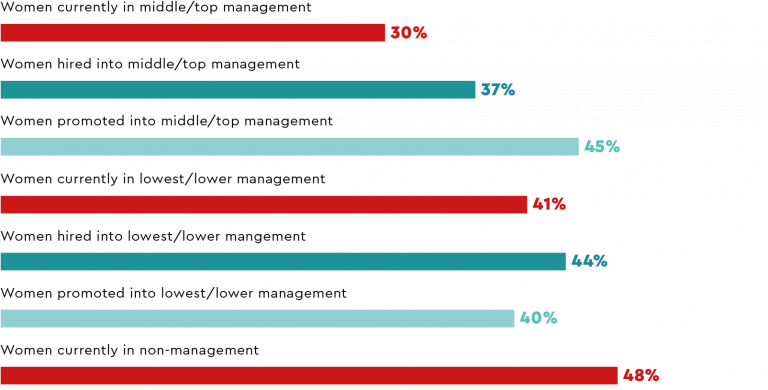At first glance, the Pharmaceutical and Medical technology (Pharma/Med-tech) industry seems gender diverse. However, while women in the Pharma and Med-tech industry are nearly equally represented in lowest management and non-management (at almost 50%!), their representation drops sharply at higher management levels. In top management, only 23% of employees are female. Many women get lost between the lowest and lower management and again between the middle and top management.
One possible reason: While women are promoted into low-level management functions, these are often not the kinds of positions that set talents up to climb the career ladder further. For instance, while 47% of employees in lowest management are women, they hold only 33% of positions with personnel responsibility. It can be assumed that women in lowest management are mainly in expert or administrative functions, which are unlikely to lead to further advancement. But: The underrepresentation of women in positions with personnel responsibility is less pronounced for Pharma/Med-tech than in the full sample of industries.
The Pharma and Med-tech industry does a better job utilizing its talent pipeline than other industries, though some women still get lost on the way to the top. Women make up 48% of non-management employees, but their share in lowest and lower management promotions is only 40%. Women’s shar on these levels currently is 41%. Therefore, promotions don’t contribute to increasing the percentage of women at these levels. The share of new hires is slightly higher.
By contrast, hires and promotions contribute to increasing the share of women in middle and top management significantly, which is a hopeful sign for an actual increase in leadership diversity in the pharma and med-tech industry. Moreover, women’s share in middle and top management promotions is higher than in the talent pipeline of lowest and lower management – the internal pipeline is utilized very well compared with the other industries.

But why are the promotion rates so low for women in lowest and lower management? What talents are getting lost along the way? The promotion gender gap primarily begins at age 31. This gap is particularly pronounced for lowest and lower management promotions, where more than half of all promotions fall into the “family primetime” between ages 31 and 40. For new hires, this is also the case, though to a slightly lesser extent. Broadening the conception of promotions and career steps to accommodate lifecycle-oriented steps may help more women advance.
Newly hired managers are less likely to be Swiss than managers already employed in the Pharma/Med-tech industry. 27% of newly hired female managers and 38% of newly hired male managers are Swiss. The share of newly hired female foreign managers is higher than that of foreign men, which is more pronounced for senior managers (where only 11% of newly hired women are Swiss). In addition, female managers already working in Pharma/Med-tech are more diverse regarding nationality than male managers.
Employment percentages in Pharma/Med-tech are exceptionally high compared to the average of all industries. In this industry, there is no strong correlation between age and employment percentage, meaning that women (or men) between the ages of 30 and 45 do not reduce their employment percentage as much as in almost all other industries. This indicates a full-time working culture that may be unattractive to those who would like to reduce their employment percentage. In fact, the turnover rates of both men and women are higher in Pharma/Med-tech than in the full sample of all industries, which may point to some dissatisfaction.
Although companies in the Pharma/Med-tech industry are already utilizing their diverse talent pipeline very well, certain obstacles remain for women and employees with diverse needs. How can companies address these?